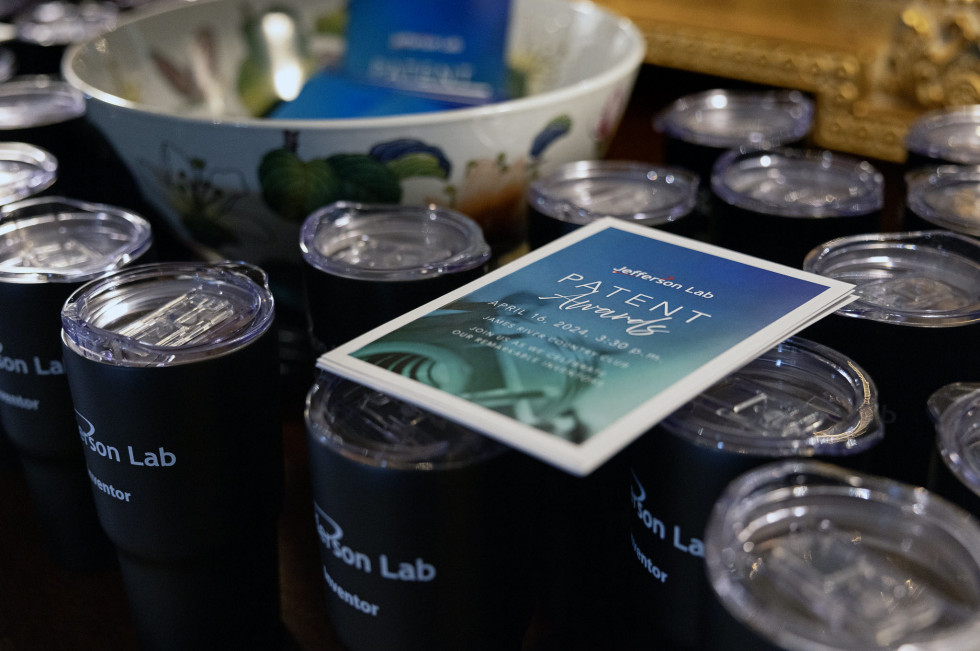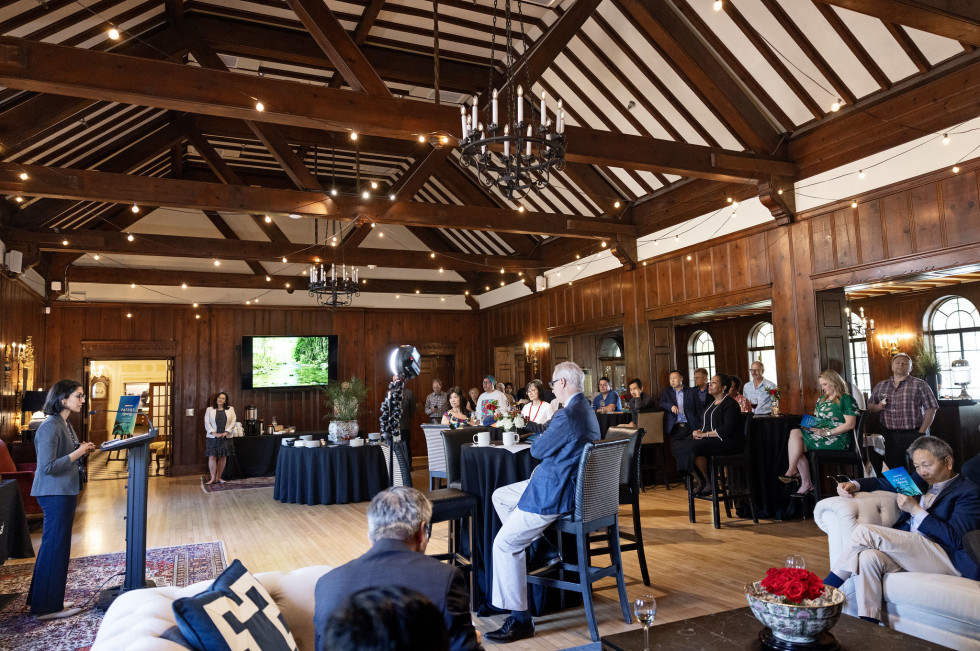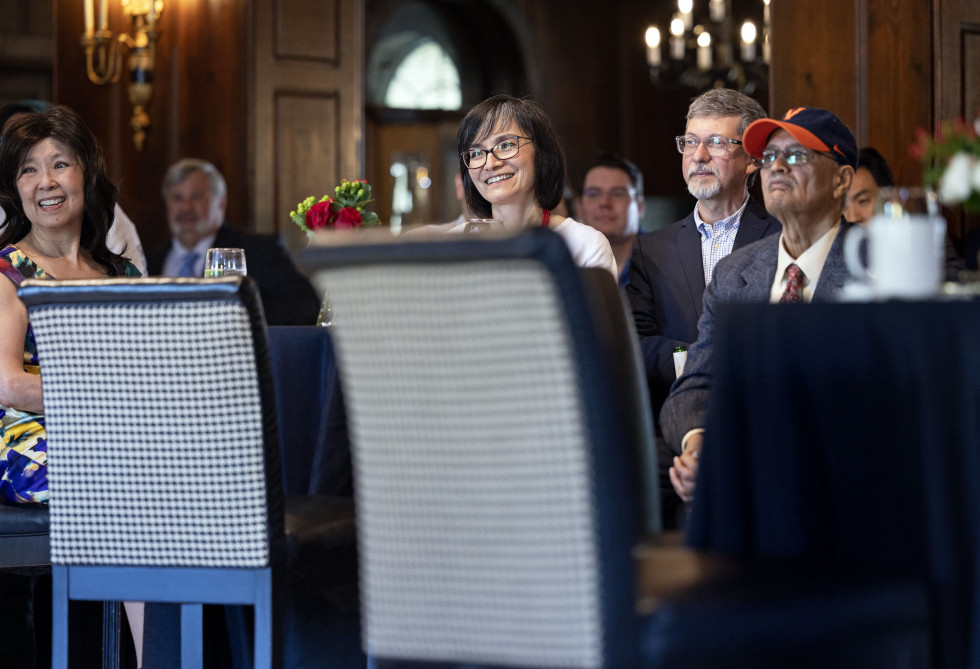Jefferson Lab photos/Aileen Devlin
The lab’s inventors were recently lauded for their creativity and passion for innovation
On May 28, 1991, the U.S. Department of Energy's Thomas Jefferson National Accelerator Facility received the first of more than 185 patents to date. These innovations were achieved by staff through research and development activities either directly involving or technologically related to the lab’s science mission.
Recently, the lab celebrated its newest patented technologies in an award ceremony honoring five years of patent success. The 2024 patent award ceremony recognized the accomplishments of more than 30 inventors who contributed to 17 patents granted in the 2019-2023 fiscal years.
According to Jefferson Lab’s Chief Innovation Officer Marla Schuchman, the ceremony honored more than innovation.
“This is really a testament to your ingenuity, your creativity, your ability to identify problems, to look for solutions, to ideate,” Schuchman said as she addressed the patentees. “And really, the laboratory wouldn't be where we are without you.”
More than 30 years of patents
A patentable invention typically is either a device or product that is based on a new idea, is useful for solving a problem, or is an improvement over existing technology. Patents protect the innovations that make new technologies possible, for up to 20 years.
In that span, the patent assignee (owner) may use the tech themselves or license it for use to other entities. And no one else may use a specifically patented device or design without permission from the patent assignee while the patent is in force.
At the time of its first patent, the laboratory was in the midst of furious activity. Jefferson Lab was the newest national lab, having just received its first funding less than a decade earlier in 1984. Staff members were focused on building, installing and commissioning a superconducting radiofrequency particle accelerator. The Continuous Electron Beam Accelerator Facility (CEBAF) would go on to become the world’s first functional large installation of SRF particle accelerator technology.
That pioneering achievement came with many technological opportunities and challenges that would be addressed by innovative designs.
During the months leading up to May 1991, workers were assembling two new sections of the groundbreaking particle accelerator every month. Called cryomodules, these modular sections of the accelerator could be installed in numbered slots inside the racetrack-shaped enclosure 25 feet underground.
The components at the heart of each cryomodule were superconductive, which required that they be cooled to an astonishing -456 degrees Fahrenheit, or about 2 Kelvin, to function properly.
That very first patent centered on ensuring CEBAF components received enough cryogenic coolant for operations. Invented by Ganapati Rao Myneni, the first patent for a cryogenic liquid-level measuring apparatus was “for measuring a level of a cryogenic fluid in a cryostat.”
Notably, Myneni bookended his career at the lab with recognition at the recent ceremony for his last Jefferson Lab patent, granted in 2019 for a high-performance SRF accelerator structure and method.
Thanks to these innovations and others, CEBAF remains a DOE Office of Science user facility that has grown to support the research of more than 1,900 nuclear physicists worldwide.
Other notable patents throughout the years addressed an assortment of issues, problems or opportunities.
An “electronic stockroom and catalog” (US-7113920-B1) would be licensed for use to Hampton University.
Two patents on aspects of a newly developed helium process cycle (US-7278280-B1 and US-7409834-B1) would be licensed for use to industry and form the basis for allowing the lab’s Cryogenics Department to upgrade the lab’s Central Helium Liquefier to operate more efficiently. The patents also paved the way for similar upgrades to cryogenic plants owned by DOE at Brookhaven National Lab’s Relativistic Heavy Ion Collider and Oak Ridge National Lab’s Spallation Neutron Source. That same cryogenic technology was later used in designing and building the new cryogenic facilities to help power an upgrade installed at the Linac Coherent Light Source facility at SLAC National Accelerator Laboratory.
In addition, the lab spawned numerous patents (including US-5568532, US-5960057, US-7884331 B2, US-8295910 B1, and US-9217744-B1) that would enervate the medical and biomedical sciences, leading to a widely deployed breast cancer imager and technologies for imaging plants and animals for noninvasive research.
According to Schuchman, each of these and the many other awarded patents represents a dedication and commitment by lab staff to see the process through to the end.
“The average time to create a full patent application is 30 to 40 hours, but that's just the beginning of the process,” Schuchman said. “There are often questions of clarification, additions or changes to claims. Oftentimes, it can take years to go through the patent process. This group really represents those who've stuck with it, who are determined and have the dedication and vision to really believe in your idea and its potential and to see it through.”
She also noted that many national lab successful transfers of technology for use in the wider world are due to the work of patentees who go above and beyond the patenting stage.
“As a basic research lab, our inventions are not always ready to go into the marketplace and be commercialized,” she said. “We work on a lot of technology that's much further upstream than that.”
This dedication has landed Jefferson Lab technologies in medical imaging suites that diagnose cancer, in devices that enable groundbreaking research on how drugs work in the brain, and in packaging on the shelves of safety supply companies.
“Our inventors work with partners, work with small businesses and others, to help develop this technology and bring it to the point for broader use,” Schuchman concluded. “Those of you who are motivated to do this type of work are really an incredible asset to the laboratory and to the Department of Energy system, and we really greatly value that contribution.”
An environment of innovation
Thanks to the diligent efforts of its patentees from across the campus, the lab has 187 patents on file with the United States Patent and Trademark Office (USPTO) as of July 2024. Parikha Mehta, special advisor to the director of the USPTO, referenced those patents when she addressed honorees and guests in the keynote at Jefferson Lab’s patent award ceremony.
“The patents that bring us here today are so much more than legal rights,” she said. “They are a testament to your ingenuity, your passion and your commitment to pushing your groundbreaking discoveries on to the next step in the innovation journey.”
Mehta applauded the laboratory’s focus on ensuring that technologies developed for science find their way to commercial, scientific and industrial entities who have a use for the technology beyond research.
“Nationwide, patents are the primary vehicle used across the economy, including within our government labs, to transform new inventions and technologies into commercial products and sometimes entirely new industries,” Mehta said. “Industries based on innovation and the protection of intellectual property generate almost $8 trillion in gross domestic product. And they account for 44% of all US jobs.”
Mehta concluded her speech by encouraging the lab’s inventors to continue on their path of innovation.
“Nurturing and protecting innovation is a core value for me and for the USPTO at large, whether you identify as a scientist, an engineer or maybe even both,” she said. “We see and respect your commitment to creative problem solving as a matter of public service, day in and day out.”
As CINO, Schuchman leads Jefferson Lab’s Research and Technology Partnerships Office. Learn how the lab partners with industry, research organizations and commercial interests via our Partnerships webpage.
The full album of event photos is available on the lab’s Flickr page.
Further Reading
Innovative Energy-Saving Process Earns Jefferson Lab Team a 2007 White House Award
Contact: Kandice Carter, Jefferson Lab Communications Office, kcarter@jlab.org





